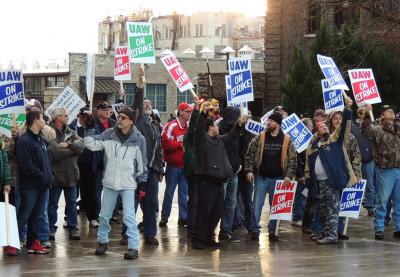“Yeah, the strike is ridiculous. Just get back to work already and stop whining,” uttered an 11th-grade American history student responding to a class-opening prompt. We’d been studying labor movements in the Gilded Age, trying to make sense of the violence, tension and disagreement between the industrial giants of that period—Carnegie and Rockefeller—and the laborers.
Like this student, a cascade of others struggled to hold back their frustrations and anger toward present-day striking workers at a local company in nearby Kohler, Wisconsin. Because my high school was situated in a largely rural, working-class area, I wondered, Why all the anger and resentment?
In November of 2015, workers at the UAW Local 833 union voted to go on strike after negotiations with the Kohler Company collapsed. The Kohler Company has a rich tradition in Wisconsin, engineering and marketing high-end bathroom products all over the world. The company and village employ many residents of the neighboring city where I taught.
Kohler, a company-planned village modeling the promise of George Pullman’s late-19th-century Pullman Towns, was no stranger to strikes—both peaceful and violent—throughout the 20th century. In 1954, workers there engaged in the longest major strike in American history. Walk by the company’s outer gates and, with enough attention to detail, you can still find the smashed windows from picketing laborers of decades past.
As I taught the Gilded Age, the 2015 strike unfurled.
In Kohler, the narrow, well-kept streets in front of the company simmered with discontent. The early sun revealed the picketers’ chants and spirit. The cold nights glowed with barrels of fire and cups of steaming coffee that fueled the strikers as they made their wage demands. Traffic slowed. Horns echoed.
For weeks, I was living history. For hours, I imagined how this moment would be remembered in the future.
Back in my classroom, for the five-minute bell ringer, my students began to think about history as it connects with lived experience in Main Street America. For some, it was their first time doing so.
I later learned that my student who first lamented the “greedy” strikers has a father working in management for the Kohler Company. That day’s discussion was an important, albeit uncomfortable, lesson about power and perspective. As I reflected afterward, this moment is what trying to teach with more relevancy and nuance is all about: confronting the uncomfortable, connecting the past with the present, and learning to face history even as it unfolds right in front of you.
A Backwards Design model of teaching allowed me to infuse local history within historical periods and themes in United States history. Researching and learning about my local context led me to create small, relevant prompts that connect to broader eras like the Gilded Age, the civil rights movement and the Vietnam War. My hope is that this approach will help bridge students’ cultures and identities with their schooling experiences.
The use of local history may also serve as an “entry point” or “hook” into a historical unit. Prior to 2016, I was part of a history department that engaged students in interviewing residents at a local retirement complex. As part of this oral history project, students learned how to listen and ask relevant questions to record personal narratives from long ago. Ultimately, speaking with an older generation that experienced the history my students were learning provided them with a unique twist to our textbook understanding of the past.
Local history can be—in fact must be—woven into students’ day-to-day lives. You don’t need to live in the storied streets of Washington, D.C., or cobblestoned Boston to make meaningful connections with American history. Lessons of power, inequality and controversy lurk right around every corner, in every classroom seat. Main Street communities are no exception. It may take a current event or a trip to the local historical society, but it’s there. Do your students and small-town communities a favor: Find it. Analyze it. Wrestle with it. And teach it.
Carreno taught high school history for three years and is currently a graduate student at the University of Wisconsin-Eau Claire.


0 COMMENTS